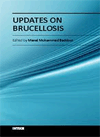Control of animal brucellosis: the most effective tool to prevent human brucellosis
The book Updates on Brucellosis edited by InTech includes this chapter
November 1st, 2015
Perez-Sancho M., Garcia-Seco T., Dominguez L. and Alvarez J..
The World Health Organization classifies brucellosis as one of the seven neglected endemic zoonosis which contribute to the perpetuation of poverty in developing countries. Although most of the developed countries are free from this important zoonosis, brucellosis has still a widespread distribution in the Mediterranean region, the Middle East, Central Asia, and parts of Latin America, making it a global problem. Nearly half a million of new cases of human brucellosis are reported each year around the world, in which animals (or products of animal origin) are the most likely source of infection. Brucella melitensis, the main etiologic agent of small ruminant brucellosis, is the most prevalent specie involved in cases of human disease in most parts of the world. Additionally, Brucella abortus (main responsible of bovine brucellosis) and Brucella suis (the most common etiological agent of porcine brucellosis) are often associated with human brucellosis. In animal production, brucellosis has a strong economic impact due not only to its direct consequences (e.g., reproductive failures) but also to indirect loses (e.g., trade restrictions). The problem of brucellosis could be considered a clear example of the need for a “One World, One Health” strategy, given that the only approach to achieve its control and subsequent eradication is the cooperation between public and animal health authorities. The prevention of human brucellosis cannot be achieved without the control of the disease in the animals, as exemplified by the impact that the early measures adopted in the beginning of the 20th century forbidding the consumption of goat milk had on the prevalence of the disease in the British soldiers in Malta. When the prevalence of the disease in the animal population is high or when eradication cannot be achieved due to other factors (e.g., lack of economic resources), its control in livestock must be the first objective. When deciding the optimal approach to tackle the disease, the prevalence of animal brucellosis is not the only parameter to consider by the decision makers since other epidemiological and economic aspects should be considered in order to implement the most adequate control strategy in each region. Cooperation between all stakeholders involved is a cornerstone in the success of any control strategy. Strict biosafety and management measures, vaccination, and test-and-slaughter strategy are recognized as the most effective strategies to control this pathology in livestock. The adequate combination of these measures depends on several factors that will determine the success of the eradication efforts. The present chapter will review the abovementioned measures for the control and eradication of brucellosis in livestock, focusing on the advantages and drawbacks of the diagnosis tools and immunization strategies currently available and evaluating new approaches based on the advance on the knowledge of different aspects of this disease and its etiological agents.
Related link: Control of animal brucellosis: the most effective tool to prevent human brucellosis
| CEI Campus Moncloa. 111 | |
 | Servicio de Zoonosis Emergentes, de Baja Prevalencia y Agresivos Biológicos (NED). Centro de Vigilancia Sanitaria Veterinaria (VISAVET). Universidad Complutense (UCM). 111 |
 | Departamento de Sanidad Animal. Facultad de Veterinaria. Universidad Complutense (UCM). 111 |
| Department of Veterinary Population Medicine. College of Veterinary Medicine. University of Minnesota (UMM). 111 | |

